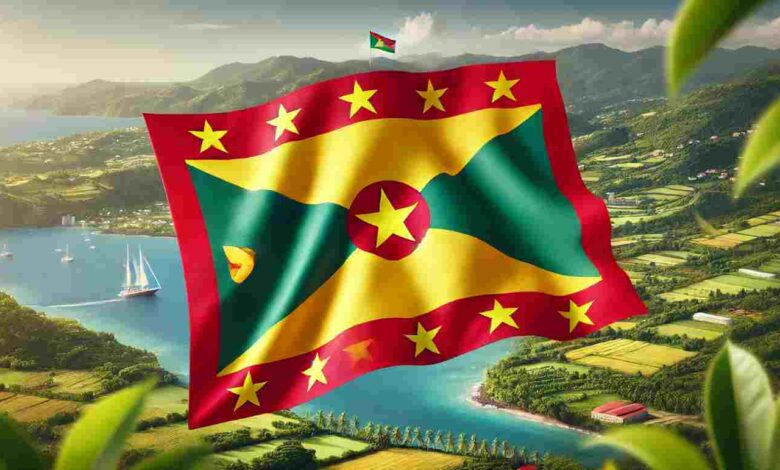History and Significance of the Grenada Flag

The Grenada flag is a powerful symbol of the nation’s history, culture, and identity. Grenada, often referred to as the “Spice Isle” due to its production of spices such as nutmeg and cinnamon, is a beautiful Caribbean country.
The Creation of the Grenada Flag
Grenada gained its independence from Britain on February 7, 1974. Prior to this, the island was a British colony. In preparation for independence, a new flag was needed to replace the British colonial flag. The newly designed flag of Grenada was adopted on this significant date and has remained unchanged since then.
The flag was designed by a team led by the then-Prime Minister of Grenada, Sir Eric Gairy. The design of the flag was meant to symbolize the country’s newfound freedom, pride, and unity as it stepped onto the world stage as an independent nation. The team aimed to create a flag that would resonate with the people of Grenada, symbolizing the island’s natural beauty, its people, and its culture.
The Design of the Flag
The Grenada flag is rectangular in shape and features a unique design, combining different colors and symbols that have deep meanings for the nation. The flag consists of three main elements: red, yellow, and green, each representing different aspects of Grenadian life and heritage.
Color Scheme:
Red: The background of the flag is primarily red. The color red is a symbol of courage and strength. It represents the bravery of the Grenadian people who fought for their independence and continue to strive for a prosperous future.
Yellow: Yellow is another dominant color in the Grenada flag, represented in the borders and the stars. This color symbolizes the richness of the nation’s agriculture, particularly its spice industry. The abundance of spices like nutmeg and cloves has been central to Grenada’s economy and identity.
Green: Green appears in the center of the flag, where a single star is placed. The green color represents the island’s lush landscapes, forests, and fertile soil. It also symbolizes hope, renewal, and the connection between the people and the land.
Symbols on the Flag:
The Star: In the center of the flag, a large yellow star sits in a green circle. The star represents the nation’s goal of unity, independence, and the pursuit of a better future. It is a reminder of Grenada’s aspirations to stand out as an independent and vibrant country.
The Seven Stars: Around the flag’s border, there are six small yellow stars arranged in a pattern. These stars symbolize the six parishes of Grenada. The seventh star, which is larger and positioned in the center of the flag, represents the capital city of St. George’s. The stars collectively signify the unity of all regions of Grenada working together towards progress and prosperity.
The Nutmeg: A small representation of a nutmeg is placed on the left side of the flag. This image is a direct nod to Grenada’s spice trade, which plays a major role in the country’s history and economy. Nutmeg, along with other spices, has been one of Grenada’s key exports, and it is an important symbol of the nation’s agricultural richness.
Historical Significance of the Flag
The Grenada flag has a deeply historical significance. It was designed to mark the country’s independence from British rule in 1974. At that time, the island was transitioning from a colonial past to a future as an independent state. The flag represented the hopes and dreams of the Grenadian people as they moved forward as a self-governing nation.
Independence and National Pride: When Grenada gained its independence, it was important to establish a flag that would symbolize the nation’s strength, unity, and cultural identity. The flag was seen as a powerful reminder that the people of Grenada were free and sovereign, no longer subject to foreign control. It marked the beginning of a new chapter in the country’s history.
Colonial Legacy: The decision to create a new flag also symbolized a break from the colonial past. Before independence, the British Union Jack was used on the flag, and the new design was a clear indication that Grenada was now charting its own path, free from the influence of colonial powers.
The Flag and the People
The Grenadian people view the flag as a source of pride and unity. It is displayed during national celebrations, independence events, and in daily life. For the citizens of Grenada, the flag represents more than just a national symbol, it is a reminder of their shared history and collective aspirations.
Unity: The flag’s elements emphasize the unity of the people of Grenada. The six smaller stars symbolize the six parishes that make up the country, and they highlight the importance of each individual region within the nation. This reinforces the message that Grenada is stronger when all its people come together as one.
Agricultural Significance: The nutmeg symbol on the flag is an important reminder of Grenada’s deep connection to agriculture and its significance to the island’s economy. Nutmeg is a key export, and the flag symbol shows agriculture’s importance in Grenada’s development.
Pride in Independence: The red, green, and yellow colors of the flag inspire national pride and a sense of accomplishment. Red symbolizes courage, while green represents the country’s fertile lands. The yellow color reminds citizens of their agricultural richness and natural beauty. These colors come together to form a flag that instills a deep sense of pride in the people of Grenada.
The Role of the Flag in Grenadian Culture
The flag of Grenada plays a central role in the cultural identity of the nation. It is not only a symbol of independence and national pride, but it is also a source of inspiration for future generations. The flag serves as a constant reminder of the sacrifices made for freedom and the aspirations of the Grenadian people.
People prominently display the flag during various cultural events, national holidays, and public ceremonies. The flag of Grenada represents the nation’s unity and culture during Independence Day, festivals, and sports events.
International Recognition: The flag is also used internationally to represent Grenada in various global forums. Whether it is displayed at the United Nations or at international sporting events like the Olympics, the Grenada flag is recognized as a symbol of the country’s independence, culture, and values. It allows people from around the world to identify Grenada as a distinct nation with its own identity.




